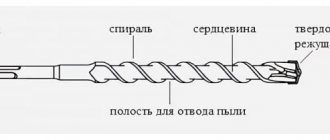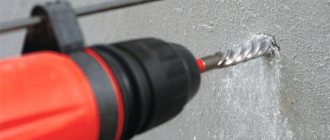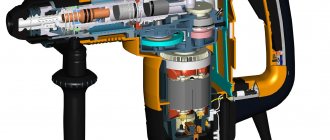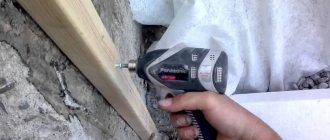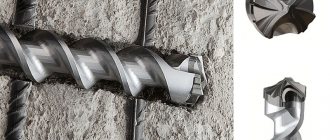Device
Regardless of the above-mentioned type, material and design features, drills for concrete hammer drills are built according to a standard principle. They are actually built from two parts: the shank and the working part. The latter, in turn, consists of 4 more zones:
- Spirals - spiral-shaped turns that help remove dust generated during the drilling process.
- The core is the main rod on which spiral-shaped turns and cavities are organized that remove dust.
- Channels for dust removal - peculiar cavities obtained due to the ribs of the spiral.
- The carbide cutting edge is the tip of the drill, which bears the main load during drilling. The effectiveness of work and the durability of the equipment depend on its quality characteristics.
How a drill for a hammer drill works Source redteh.ru
Important! When choosing a good concrete drill, pay attention to the location of the cutting plate. It should “sit” firmly in the saddle and be located strictly in the center.
Labeling and classification
The main marking of drills takes place with an eye to the size of the equipment. The indicator is determined by its purpose: to obtain a through hole, a recess for an anchor or a thin dowel-nail. Based on the specifics of requests, generally accepted marking is carried out.
- Total length.
- Diameter.
- Shank type.
Healthy! An example of marking a drill with an SDS-plus shank 210 mm long, 10 mm in diameter: 10x210, SDS-plus. According to this principle, all equipment is “read” not only for rotary hammers, but also for drills.
Drill tail
The shank is a wear-resistant part of the drill, made of high-strength hardened steel, inserted into the hammer drill chuck. It is the shape of the shank that primarily distinguishes the drill from a similar twist drill. The professional eye of a master will determine without error whether the drill is suitable for a particular type of hammer drill, and construction beginners will be helped to understand this by the accepted marking of SDS shanks (Special Direct System - “special control system” developed by Bosch):
- sds plus drill is the most common type of shank with a diameter of 10 mm, the length of the part inserted into the hammer drill chuck is 40 mm. For installation, it has four open slots that accept torque. Such drills, having a diameter of 4 - 26 mm, are used on light construction professional and household hammer drills.
- The sds max drill bit is the second most common type of shank used for large diameter drill bits (over 26 mm) used in heavy and powerful rock drills, such as electric jackhammers. The diameter of such a shank is 18 mm, the length of the part inserted into the chuck is 90 mm.
- sds top is a somewhat intermediate and less common type of shank with a diameter of 14 mm and a length of 70 mm, having two open and two closed grooves for installation in a hammer drill chuck. Typically used on drills with a diameter of 16 - 26 mm.
- sds quick - created in 2008, a unique hexagonal type of shank with keys instead of grooves and a holder into which drills and screwdriver bits can be inserted. Applicable only to Bosch Uneo/Uneo Maxx rotary hammers.
Shank type
Shanks on drills are classified according to external characteristics. Unlike drill bits, their dimensions are not affected by the diameter and length of the equipment, which allows them to be used with any hammer drills with a suitable type of chuck.
Popular shank for concrete drills Source uainfo.com
We will consider only those that can be encountered in everyday life, that is, applicable to modern rotary hammers. They bear the general name SDS, which is further divided into several categories.
SDS is the first model that served as a prototype for all modern equipment for this purpose. It has a diameter of 10 mm and 2 channels, ensuring reliable contact with the torque of the chuck. It goes in only 4 cm deep.
SDS-plus is the most popular group. With a diameter of only 10 mm, it deepens into the cartridge by 4 cm. The advantage and difference from the founder of the group, the SDS shank, lies in the twofold superiority in the number of recesses. There are 2 closed and 2 open channels. The latter here work as guides, while the closed ones play the role of a stopper and are intended for locking bearings. The area in contact with the wedges is only 75 mm2.
The main segment with which such equipment is used is household and professional small-sized hammer drills (lightweight). The diameter of the drills varies from 4 to 26 mm, and the length from 110 to 1,000 mm.
What is the difference between SDS-max and SDS-plus Source ferrocom-ekb.ru
Healthy! SDS and SDS-plus shanks are completely interchangeable
SDS-max is an equally popular drill shank. Belongs to the category of equipment for large tools. The element has a seat diameter of 18 mm, and the surface of the contacting wedges is 389 mm2. It has 5 grooves, 3 of them are open, 3 are closed. As already mentioned, the size of the tool with which such drills are used is fundamentally different from household equipment and is used in industry and large-scale construction. Only in a chuck this type of shank fits 9 cm.
The most popular types of concrete drill shanks Source detaltorg.ru
Sandpaper grit
Depending on the abrasive crumb fraction, base material and purpose, the entire range of produced abrasive cloth can be divided into several modifications.
Based on the grain size, the following types of sanding cloths are distinguished: fine-grained and coarse-grained. The table shows the grit values of the most commonly used sandpaper:
Initial grindingcorrection of minor surface defects
| GOST R 52381-05 | GOST 3647-80 | Grit size, microns | Scope of application |
| Coarse grain | |||
| P22 | 80-N | 800-1000 | Pre-cleaning |
| P24 | 63-N | 630-800 | |
| P36 | 50-N | 500-630 | |
| P40 | 40-N | 400-500 | Rough wood processing |
| P46 | 32-N | 315-400 | |
| P60 | 25-N | 250-315 | |
| P80 | 20-N | 200-250 | Initial grinding Correction of minor surface defects |
| P90 | 16-N | 160-200 | |
| P100 | 12-N | 125-160 | |
| P120 | 10-N | 100-125 | |
| P150 | 8-N | 80-100 | Treating hardwood before final sanding Sanding soft wood Removing old paint |
| P180 | 6-H | 63-80 | |
| Fine sandpaper | |||
| P240 | 5-H; M63 | 50-63 | Finish sanding of hard wood Intermediate grinding |
| P280 | 4-H; M50 | 40-50 | |
| P400 | M40; N-3 | 28-40 | Surface polishing Sanding for painting Wet grinding |
| P600 | M28; N-2 | 20-28 | |
| Р1000 | M20; N-1 | 14-20 | Sanding ceramics, plastics and metals Wet grinding |
| P1200 | M400 | 10-14 | Polishing, de-glossing |
| Р1500 | M10; N-0 | 7-10 | |
| P2000 | M7; N-01 | 5-7 | |
| Р2500 | M5; N-00 | 3-5 | |
As can be seen from the grain size table, the scope of application of sandpaper is quite wide:
- Carpentry and furniture industries;
- Mechanical engineering and industrial production;
- Manufacturing of non-standard equipment and instrumentation;
- Car repair and painting;
- Construction and finishing works.
This is far from a complete list, and the ways of using sandpaper in everyday life cannot be described at all due to its endless variety.
The most common are three forms of produced emery cloths:
As for the release form, the most common are sheet and roll. In addition, there are ready-made ring modifications for scraping and hand grinders, disk pads for electric drills and some other varieties.
Working part
As already mentioned, the middle (helical) part of the drill is responsible for the timely removal of dust from the hole. It can be manufactured in different designs, and accordingly it will be classified differently.
- Classic auger drill - designed for drilling deep holes. Due to the optimally selected spiral design and nominal rotation speed, it effectively removes dust. This reduces the load on the tool and the time spent on performing a specific task.
- Small angle of inclination - used with a tool that has low impact inertia. The optimal purpose is to obtain a large number of holes, small in size (with a diameter of no more than 10 mm, a depth of up to 800 mm).
- Large inclination angle - such equipment has an excellent dust removal rate, which affects drilling performance. Designed for drilling through and non-through holes. However, the optimal effect is achieved by obtaining a single hole of large diameter and depth.
Classification of drill bits for rotary hammers by size
The size of the drill is one of the main characteristics of the product with which a purchase in a store begins, and is directly related to its purpose: drilling holes of the required diameter and depth. The drill size traditionally consists of two defining parameters, selected to solve specific problems:
- Total length . The maximum length of the drill together with the shank offered in stores is 1000 mm, the minimum is 100 mm. The physics of drilling does not allow the use of a longer drill: it is almost impossible to work with a longer tool. The length of the drill is closely related to its diameter: both of these parameters must be technically balanced and ensure reliability and safety of drilling.
- Outside diameter . As mentioned above, the diameter depends on the length and, additionally, on the type of shank - for example, the maximum diameter of an sds max drill is 50 mm and no more. The diameter value is always an even number, and the marking of fasteners follows the same principle.
Here are the main points regarding the sizes of drill bits for rotary hammers. To carry out household repair work, it is recommended to use a comprehensive solution by purchasing a set of drills for rotary hammers. Standard diameters offered are 4, 6, 8, 10, 12, 14 and sometimes 16 mm.
Tip
Different types of metals are used in the manufacture of equipment. For example, alloy tool steel is used in the production of the rod and shank. For the cutting element (tip), pobedit or diamond brazing is used. This allows not only to significantly increase the service life of the equipment, but also has a positive effect on its productivity.
The peculiarity of drilling holes in concrete with a hammer drill, when compared with working with conventional drills, is that the degree of sharpening does not matter here. As a result of dulling, performance decreases, but not significantly. The main factor in this situation is the solder size. As soon as its width becomes less than the diameter of the drill rod, problems will arise with the subsequent installation of the anchor or dowel-nail plug.
Important! The diameter of the hole will correspond to the size of the drill only if the nozzle is not ground off by 70 percent or more.
Nozzle material
As already mentioned, the tip of a concrete drill can be made in the form of pobedit or diamond brazing. They differ from each other in many ways, from chemical composition to operational characteristics.
How to choose the right concrete drill
There are many different hammer drills for drilling concrete on the modern market. They should be selected based on the characteristics of the material to be processed.
Auger type tools
The most common type of tool used for drilling concrete is auger drills. Their cutting part, as a rule, is equipped with a pobedite soldering, made in the form of a blade or four separate teeth. Due to their exceptionally high hardness, the pobedit tips of such drills do not require regular sharpening and can successfully serve for a long time without losing their original characteristics. To more effectively remove dust from the drilling area, a groove located in a spiral is made on the leg of such drills. To give the tool the required hardness and wear resistance, it is hardened using various technologies.
Concrete drill with auger-type spiral
It should be borne in mind that some dishonest manufacturers do not harden concrete auger drills in the proper way, but simply paint their working part golden color using the electroplating method. Naturally, such tools fail very quickly. Inexpensive and not very high-quality drills have a number of other disadvantages:
- The instrument has a too thin stem, as manufacturers skimp on metal for its manufacture. Such deviations in geometric parameters often lead to leg breakage.
- Instead of high-quality tool steel, manufacturers of inexpensive drills use cheaper and lower quality material.
The most popular sizes of auger-type drills, which are used to perform repairs and simple installation work around the house, are 6x110, 60x210, 8x110, 10x110, etc.
Auger-type drill bit ensures precise drilling and high drilling speed
Spiral drills for drilling deep holes
The working part of spiral-type drills, when compared with auger ones, looks thinner. This is because the spiral grooves of such drills are more pronounced. Spiral drills are used for drilling deep, large-diameter holes in concrete. Drills of this type are popular with any specialist involved in installing air conditioners and laying electrical communications. You cannot do without such tools when performing construction and complex repair work.
Double-pronged spiral drill for concrete and stone
When choosing spiral drills for concrete, it is better to give preference to high-quality, expensive products that can last much longer than low-grade, but not so cheap, spiral-type tools. The high price of high-quality spiral drills is explained by the fact that strong tool steel is used for their manufacture, and this is precisely the material that can successfully withstand all types of loads.
When drilling a deep hole, the tool used experiences long-term bending loads, the direction of which is constantly changing. Only a drill made of high-quality steel of the appropriate grade can withstand them and not break. When choosing an inexpensive product of questionable quality, you should keep in mind that its resource may not be enough to drill even one long hole. Situations when such drills break without drilling even half of the hole created occur in two out of three cases.
Core Drilling Tools
To drill large-diameter holes in concrete structures, which are necessary for installing pipes and installing electrical sockets, core-type drills are used. Their main element is a metal cup (crown) with a shank, on the working end of which the cutting teeth are securely fixed. They can be diamond or pobedite. In the central part of such a crown there is a drill with a screw thread, protruding 1–2 cm beyond the cutting part of the crown. It is necessary in order to center the hole being created.
Impact drill bit with carbide teeth
Diamond core drills for drilling concrete can successfully cope even with structures reinforced with metal reinforcement. Such tools, the cost of which is quite high, are most often chosen by those who are professionally involved in construction and repair. To perform simple one-time work around the house, you can select and purchase a more budget model.
Diamond core bit complete with SDS-plus adapter and center drill 6 mm in diameter
Drill shanks for concrete drilling
Depending on the equipment used, concrete drill shanks may fall into one of the following categories:
- cylindrical (such shanks are equipped with tools used in conjunction with electric drills);
- SDS-plus, on the surface of which special grooves are made (shanks of this type are equipped with drills used in conjunction with medium-power rotary hammers);
- SDS-max (such shanks are equipped with tools for professional series rotary hammers, which are distinguished by the highest power).
Main types of drill shanks for rotary hammers
In some situations, it is possible to use special adapters that allow you to install a drill with a cylindrical shank into a hammer drill chuck. Meanwhile, it is not recommended to use hammer drills to equip conventional drills, since the increased loads placed on the power tool in this case contribute to its rapid failure.
Adapter for hammer drill for drill with cylindrical shank
Materials for the manufacture of cutting parts
The materials from which the cutting part of drills for drilling concrete are made can be artificial diamonds or pobedit. Depending on its chemical composition, the victorious alloy can correspond to different degrees of hardness - low, medium and high. The hardness of the cutting part of the concrete drill is selected based on the characteristics of the material being processed. Drills with a diamond cutting part have the highest hardness. Only they, as mentioned above, are able to cope with concrete structures reinforced with metal reinforcement.
The shape of the drill head affects the speed and efficiency of work
